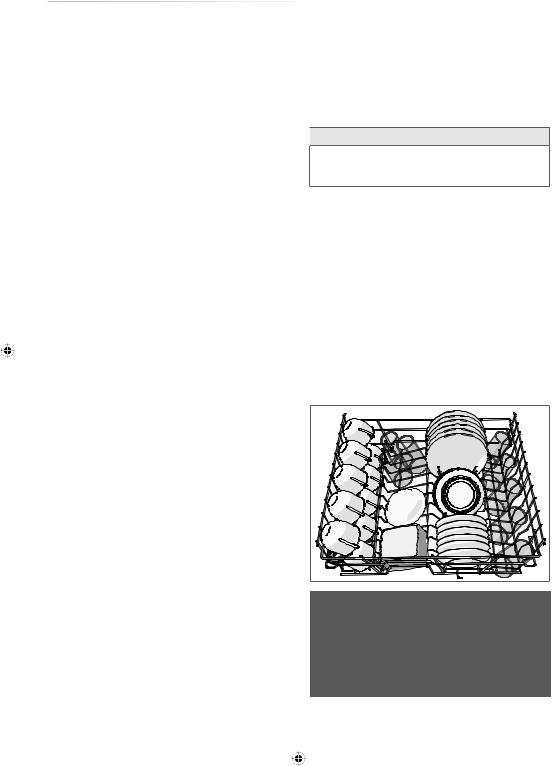Gorenje GVSP164J operation manual [de]

EN
OPERATING INSTRUCTIONS
DISHWASHER GVSP164J
www.gorenje.com

Contents |
|
Your dishwasher ........................................................................................ |
2 |
Safety instructions ..................................................................................... |
3 |
Before washing for the first time ............................................................... |
4 |
Loading the dishwasher ............................................................................ |
6 |
Using the dishwasher ................................................................................ |
8 |
Settings ..................................................................................................... |
12 |
Care and cleaning ..................................................................................... |
15 |
Troubleshooting ........................................................................................ |
18 |
Installation ................................................................................................. |
25 |
Service ...................................................................................................... |
27 |
Information for test institute ....................................................................... |
28 |
Technical information ................................................................................ |
32 |
Your dishwasher
|
|
|
|
|
|
|
|
|
|
|
|
|
|
|
|
|
|
|
|
|
|
|
|
|
|
|
|
|
|
|
|
|
|
|
|
|
|
|
|
|
|
|
|
|
|
|
|
|
|
|
|
|
|
|
|
|
|
|
|
|
|
|
|
|
|
|
|
|
|
|
|
|
|
|
|
|
|
|
|
|
|
|
|
|
|
|
|
|
|
|
|
|
|
|
|
|
|
|
13 14 |
|
1 |
2 |
3 |
4 |
5 |
6 |
7 |
8 |
9 |
10 |
11 |
12 |
|||||||
1. |
Main power switch |
|
|
|
|
|
8. |
SpeedWash |
|
|
|
|
|||||||
2. |
Programme selector |
|
|
|
9. |
Auto open |
|
|
|
|
|||||||||
3. |
Daily wash |
|
|
|
|
|
|
|
|
|
10. |
Half load |
|
|
|
|
|||
4. |
Intensive wash |
|
|
|
|
|
|
|
11. |
Delayed start |
|
|
|
|
|||||
5. |
Eco wash |
|
|
|
|
|
|
|
|
|
12. |
Display |
|
|
|
|
|||
6. |
Quick wash |
|
|
|
|
|
|
|
13. |
Rinse aid indicator |
|
|
|
||||||
7. |
Rinse |
|
|
|
|
|
|
|
|
|
14. |
Salt indicator |
|
|
|
|
|||
2

Safety instructions
General
•Read the operating instructions and keep them in a safe place!
•Never use the dishwasher for any purpose other than that specified in these operating instructions.
•Do not load the dishwasher door or dishwasher baskets with anything other than dishes.
•Never leave the dishwasher door open as someone may trip on it.
•Use only dishwasher detergent!
•This machine can be used by children aged 8 and upwards, and by people with reduced physical capacity, mental ability, memory loss or lacking experience and knowledge. These individuals must be supervised when using the machine or have instructions on how to use the machine and understand the risks that can occur. Cleaning of the machine must not be carried out by children without supervision.
•Damaged mains cables must only be replaced by a qualified electrician.
•Only use the dishwasher in household-type environments for dishwashing household dishes. All other use is prohibited.
•Never place dishes with solvent residues in the dishwasher due to the risk of explosion. Nor may dishes that contain ash, wax or lubricants be washed in the dishwasher.

 WARNING!
WARNING!
Knives and other pointed items must be placed with the points down in the cutlery basket or horizontally in other baskets.
Installation
See the chapter Installation.
Child safety
Children must be watched. Do not allow children to use or play with the dishwasher. Be especially vigilant when the door is open. Some detergent may remain inside! After adding detergent, always start the dishwasher immediately.

 WARNING!
WARNING!
Children must be supervised – dishwasher detergent is corrosive!
Winter storage/transport
Store the dishwasher above freezing and avoid long transport distances in very cold weather. Transport the dishwasher upright or laying on its back.
Overflow guard function
The overflow protection starts pumping out the machine and turns off the water supply if the water level in the dishwasher exceeds the normal level. If the overflow protection is triggered, turn off the water supply and call the service department.
Packing material
The packaging protects the product during transport. The packaging material is recyclable. Separate the different packaging materials to help reduce raw material use and waste. Your dealer can take the packaging for recycling or direct you to the nearest recycling centre. The packaging is comprised of:
•Corrugated cardboard made from up to 100% recycled material.
•Expanded polystyrene (EPS) with no added chlorine or fluorine.
3

•Supports made from untreated wood.
•Protective plastic made from polyethylene (PE).
Disposal
The dishwasher is manufactured and labelled for recycling.
When the dishwasher has reached the end of its service life and is to be disposed of, it should immediately be made unusable. Pull out the power cable and cut it as short as possible.
Contact your local authority for information about where and how your dishwasher should be correctly recycled.
Before washing for the first time
Checking water hardness
In order to achieve good dishwashing results, the dishwasher needs soft water (water with low mineral content). Hard water leaves a white coating on dishes and the dishwasher.
Water hardness is specified using the German water hardness scale (°dH) or the French water hardness scale (°fH).
A water supply with a water hardness in excess of 6°dH (9°fH) must be softened. This is done automatically with the aid of the built-in water softener. In order for the water softener to function optimally, it must be adjusted to the hardness of the water supply. Once you have adjusted the water softener, use detergent and rinse aid doses suitable for soft water.
Contact the local waterworks to check the water hardness in your area.
Make a note of the water hardness:____________
If the water hardness exceeds 50°dH (89°fH), we recommend connecting an external water softener.

 WARNING!
WARNING!
Hard water leaves a white coating on dishes and inside the dishwasher. It is therefore important that you select the right setting for the water softener! See Water hardness.
Never run the dishwasher with an empty salt compartment if the water supply has a water hardness in excess of 6°dH (9°fH).
4

Set the Water hardness
Chapter Settings describes how to adjust the water softener.
 Top up with salt
Top up with salt
Salt compartment lid
1.Unscrew the salt compartment lid.
2.Place the funnel supplied with the dishwasher in the salt compartment top-up hole. First, pour in about 1 l of water.
3.Then add salt, a maximum of 1.0 kg, until the compartment is full. Use large grain salt or special dishwasher salt.
4.Wipe up any excess salt so that the lid can be screwed on firmly.
In order to avoid rust stains a dishwashing programme must be started immediately after adding salt.
Set the Rinse aid
The section Settings describes how to set the rinse aid dosage.

 Top up with rinse aid
Top up with rinse aid
Drying is faster and a better result is achieved if you use rinse aid. You will also
achieve a better dishwashing result with clear and spotless dishes.
Press to open
1.Open the rinse aid compartment lid.
2.Carefully top up with rinse aid to the level marked max.
3.Wipe up any splashes of rinse aid around the compartment.
4.Close the lid firmly.
5

Loading the dishwasher
Greener dishwashing
•Do not rinse under running water. Simply scrape off large food particles before loading the dishwasher.
•Choose an environmentally-friendly detergent. Read the environmental declaration on the packaging!
•Do not start the dishwasher until it is fully loaded to save energy.
•If the dishes are only slightly dirty, you can select a programme with a low temperature.
•Better drying results are achieved if you use the Auto open option, which automatically opens the dishwasher door. Wait until the dishwasher indicates that the programme has ended and the dishes have cooled before unloading the dishwasher. (If the dishwasher is built-in the surrounding furnishings must be resistant to any condensation from the dishwasher.)
Fragile dishes
Some cookware is not dishwasher safe. This can be for several reasons. Some materials cannot withstand strong heat, others can be damaged by dishwashing detergent.
Exercise caution with, for example, handmade items, fragile decoration, crystal/glassware, silver, copper, tin, aluminium, wood and plastic. Look for the "Dishwasher safe" marking.
Points to consider
•All dirty surfaces should face inwards and downwards!
•Dishes should not be placed in or on each other.
•Angle dishes with hollows, such as cups, so that the rinse water will run off. This is also important for plastic items.
•Make sure small items cannot fall through the dishwasher basket; place them in the cutlery basket.
 NOTE!
NOTE!
Check that the spray arms can rotate freely.
The dishwasher's baskets
The dishwasher is equipped with an upper basket and a lower basket with a cutlery basket.
Upper basket
Place glasses, cups, bowls, side plates and saucers in the upper basket. All dirty surfaces should face inwards and downwards! Wine glasses are placed on the wine glass shelf and knives are placed in the knife stand on the right (if fitted).
6

Raising and lowering the upper basket
1.Pull out the upper basket.
2.Grab the sides of the upper basket with both hands and lift it up.
3.Repeatedly lift the basket with both hands to change its position. (The upper basket can be set in three positions.) When the upper basket is in the highest position lifting it will return it to the lowest position. Note that both sides of the basket must always be set to the same height.
out as much as possible. Ensure that spoons do not stack inside each other.
Place the cutlery basket in the lower basket.
Lower basket
Place plates, side plates, serving dishes, pots and cutlery (in the cutlery basket) in the lower basket.
Cutlery basket
Place cutlery with the handles facing down, except for knives, and spread them
7

Using the dishwasher
Add detergent
Press to open
1.Prewash detergent compartment
2.Main wash detergent compartment
Detergent is added according to water hardness.
Follow the instructions on the detergent packaging. This dishwasher is fitted with a water softener, so use detergent and rinse aid doses suitable for soft water.
Too much detergent can result in less effective dishwashing and also entails greater environmental impact.
The detergent compartment must be dry when adding detergent. There is one compartment for the prewash and one for the main wash. If powder or liquid dishwasher detergent is used, add a small amount of the detergent to the prewash compartment. Contact the detergent manufacturer if you have questions about the detergent.
 NOTE!
NOTE!
Useonlydishwasherdetergent!Washing up liquid must not be used as the foam that forms prevents the dishwasher from operating effectively.
Dishwasher tablets
Halve the tablet if it is difficult to close the dispenser lid. There is a risk that the
detergent will not be released properly if the lid is tight and will not open correctly.
 NOTE!
NOTE!
Dishwasher tablets are not recommended for short programmes (less than 75 minutes). Use powder or liquid dishwasher detergent instead.
All-in-one detergent
There are many types of all-in-one detergents on the market. Read through the directions for these products carefully.
Chapter Settings describes how to activate TAB (3-in-1/ All-in-one detergent). Note that salt must be put in the salt compartment. If you are not satisfied with the dishwashing or drying results, deactivate the setting TAB (3-in-1/ All-in-one detergent) and top up with salt, detergent and rinse aid. See Chapter Before washing for the first time.
 NOTE!
NOTE!
Optimal washing and drying results are achieved by using normal dishwasher detergent together with separately dispensed rinse aid and salt.
 The main power switch
The main power switch
Press and hold the main power switch until the display lights up. Also check that the water tap is on.
8


 PROGRAMS - Select a programme
PROGRAMS - Select a programme
Select a programme to suit the type of dishes and how dirty they are.
Press the Programme selector one or more times until the desired programme symbol is activated.

 Daily wash
Daily wash
An effective programme for daily use for slightly dried leftovers. (This programme is not intended for burnt food, such as on oven dishes.)

 Intensive wash
Intensive wash
Programme for very dirty dishes, such as pans, casserole dishes and oven dishes. Also ideal for situations where demands on hygiene are especially high, such as when dishwashing baby bottles and cutting boards. If these dishes do not completely fill the dishwasher, you can add plates and the like.

 Eco wash
Eco wash
This programme is intended for cleaning normally dirty dishes and is the most effective programme in terms of combined energy and water consumption.

 Quick wash
Quick wash
This programme is used for glasses and porcelain that is slightly dirty, such as coffee cups.
IncombinationwithSpeedWash,ashorter programme is achieved (15 minutes).
 Rinse
Rinse
Used to rinse dishes while you wait for the dishwasher to become fully loaded.
EXTRA - Select an option
To select an option, press one of the option buttons until the option is activated. The available options vary between programmes and some options cannot be combined (available options glow dimly).
 SpeedWash
SpeedWash
This option shortens the programme time, but uses more energy and water.
 Auto open
Auto open
The dishwasher door opens automatically, which improves the drying results. Wait until the dishwasher indicates that the programme has ended and the dishes have cooled before unloading the dishwasher. (If the dishwasher is built-in the surrounding furnishings must be resistant to any condensation from the dishwasher.)
 NOTE!
NOTE!
The dishwasher door must not be blocked when set to open automatically. This can disrupt door lock functionality.

 Half load
Half load
This option adapts the dishwashing programme to a half-filled dishwasher, using less energy and water.
Delayed start
When you select Delayed start the dishwasher will start 1-24 hours after you close the door.
9

1.Press the button once to activate Delayed start. Press the button several times – or hold it in – to set the desired number of hours.
2.Close the door and the dishwasher counts down 1 hour at a time and starts after the selected delay.
If you want to cancel the Delayed start option, open the door and press and hold the main power switch until the display turns off.
Starting the dishwasher
Close the door to start the dishwasher. If the main power switch is on the dishwasher will start automatically when the door is closed.
TIME - Time remaining
Once you have chosen a programme and options, the time the programme took when last used is displayed.
Stoppingorchangingaprogramme
If you want to change programme after starting the dishwasher, open the door then press and hold the main power switch until the display turns off. Add more detergent if the lid of the detergent dispenser has opened. Then press the main power switch, choose a new programme and close the door.
If you want to load more dishes
Open the door. The dishwasher stops automatically. Add the dishes and close the door. After a while, the dishwasher continues the programme.
If the dishwasher is turned off due to a power failure
If the dishwashing programme was not finished, the interrupted programme continues when power is restored.
 NOTE!
NOTE!
During drying, the programme is interrupted if the power is cut or the door is open for more than 2 minutes.
Once the programme has finished
The dishwasher switches off automatically after the programme ends. Shut off the water tap after each use.
How to get the best drying results
•Fully load the dishwasher.
•Angle dishes with hollows, such as cups, so that the rinse water will run off. This is also important for plastic items.
•Top up with rinse aid or increase the rinse aid dosage level.
•Activate the Auto open option.
•Allow the dishes to cool before unloading the dishwasher.
Unloading the dishwasher
Hot porcelain is more fragile. Leave the dishes to cool in the dishwasher before unloading them.
Unload the lower basket first to avoid any water drops from the upper basket falling onto the dishes in the lower basket.
10
